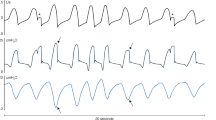Abstract
Alarms in the operating room remain a major source of annoyance and confusion. A previous study by Kestin et al. utilized a specific combination of distinct, separate monitors in 50 pediatric patients. He reported a mean of 10 alarms per case with a mean frequency of one alarm every 4.5 minutes. The alarms were classified as spurious (75%), change outside the alarm limits (22%), or patient risk (3%). We performed a similar study with 50 adult patients under general anesthesia with default alarm settings on an integrated monitor, (Cardiocap™, Datex, Helsinki). In our study, the number of alarms averaged 3 per case with a mean frequency of one every 34 minutes. Spurious alarms (those caused by electrocautery, accidental patient movement, or other non-physiological reasons) represented only 24% of all alarms. Those alarms sounding that were outside the limits occurred at a rate of 53%, and those that were considered patient risks occurred at a rate of 23%. Of the alarms, 67% occurred during the beginning and end of anesthesia. The end-tidal carbon dioxide accounted for 42% of the alarms, mostly during intubation and extubation. Suggestions are made for further improvement in alarm systems.
Similar content being viewed by others
References
Kestin IG, Miller BR, Lockhard CH. Auditory alarms during anesthesia monitoring. Anesthesiology 1988; 69: 106–109.
Schulte GT, Block FE Jr. Comparison of non-invasive blood pressure measurements on the arm and the ankle. Anesthesiology 1989; 71: A408.
Block FE Jr, Detko GJ Jr. Minimizing interference and false alarms from electrocautery in the Nellcor N-100 pulse oximeter. J Clin Monit (1986) 2: 203–205.
Author information
Authors and Affiliations
Additional information
This study was supported in part by a grant from Datex Division. Instrumentarium Corp. Helsinki, Finland.
Rights and permissions
About this article
Cite this article
Block, F.E., Schaaf, C. Auditory alarms during anesthesia monitoring with an integrated monitoring system. J Clin Monit Comput 13, 81–84 (1996). https://doi.org/10.1007/BF02915842
Received:
Accepted:
Issue Date:
DOI: https://doi.org/10.1007/BF02915842




